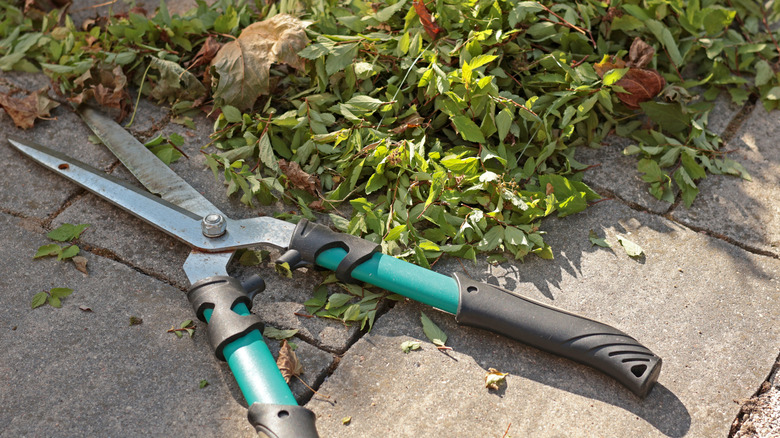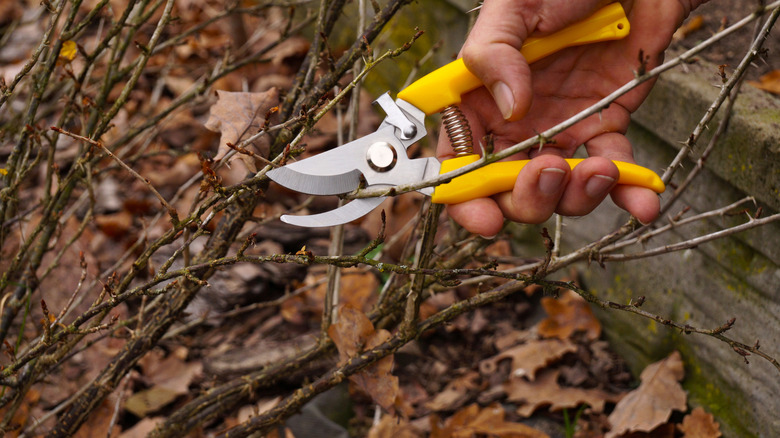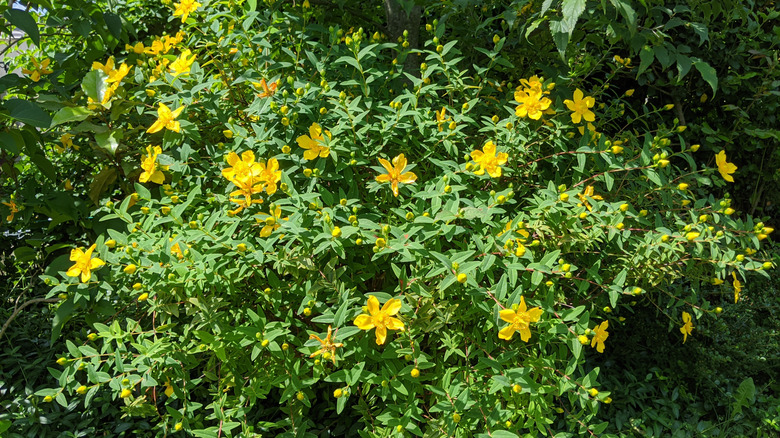The One Shrub You Should Be Pruning In Late Winter For A Healthier Spring
It happens to all of us. The calendar still says it's winter, but you feel the itch to get outside and start working in the garden. One of the mistakes to avoid while pruning your plants is cutting off stems and branches at the wrong time of the year. Many early-season bloomers, like forsythia, lilacs, and honeysuckle, need to be pruned later in the year or you risk chopping off future flowers. Waiting for the right moment can feel like an eternity to the passionate gardener. Thankfully, there's one popular shrub that not only tolerates a late-winter haircut; it actually prefers it. The plant in question is St. John's wort, and if you want a summer filled with yellow flowers, tidy, mounding growth, and an overall very attractive plant, grab your shears before it starts to sprout new growth.
St. John's wort (Hypericum spp.) are easy-to-grow shrubs that are best known for their delicate texture and buttercup-yellow flowers. They grow well in USDA Hardiness Zones 3 to 8 and have a habit of flowering on wood that grows during the current season. It's this quirk that makes winter, when most flowering shrubs are dormant, the best time for a trim. A well-timed cut encourages the plant to put all of its springtime energy into developing new, stronger stems that will be loaded with flowers during the summer season. A word of warning: common St. John's wort (Hypericum perforatum) is a listed noxious weed in much of the Midwest and should not be planted or moved — or pruned, for that matter — in those areas.
Shape your St. John's wort shrub with a hard prune
St. John's wort species flower on fresh growth, and that makes pruning pretty straightforward. In fact, pruning is a necessary part of caring for this pretty shrub family, especially for older, neglected plants that have become leggy or untidy. To start, follow the three D rule to properly prune your plants: remove any parts of the shrub that are dead, diseased, or damaged. Next, you need to do a hard prune right back to the live wood, especially for plants that are overly large or looking particularly sparse.
A good rule of thumb to follow when hard pruning St. John's wort is to remove 50 to 75 percent of the top growth. While this may sound extreme, such an extensive trim encourages the plant to produce new growth from its base, resulting in a fuller, more rounded, and arguably more attractive shape. The plant's energy is redirected into growing lots of new shoots instead of producing a few tall, skinny branches. To ensure this mounding growth habit and healthier regrowth, make your cuts just above an outward-facing node or bud. Any new shoots will grow outward from this point.
Prune St. John's wort at the right time in winter for more flower
Getting the timing of this late-winter St. John's wort pruning right is as important as mastering the technique — especially if you want to coax the most possible beauty from your shrub. You are looking for a sweet spot: after the threat of the worst winter weather has passed, but before the shrub starts to sprout new leaves and buds in the very early spring. Prune your St. John's wort too early, and you could expose the plant to a late freeze, damaging or even killing it. Prune it too late, and you could cut off that vital early spring growth.
By pruning your shrub while it's dormant, you give it a head start on producing the new stems on which bright yellow flowers will sprout from starting in the mid-summer. The more new shoots the plant grows, the more space for flowers, which is why you see more blooms on trimmed shrubs than those left untrimmed. An annual hard prune also ensures a healthier shrub and prevents it from becoming too dense and woody in the center. At minimum, you should remove old stems yearly to lightly shape the plant. It's one of the best ways to tame your overgrown shrubs and improve their overall look.


